Solana is actively transforming "blockchain technology" into infrastructure, emphasizing its financial attributes and institutional application capacity.
Author: @zhouKelvinZzzz
In the second half of 2025, Solana's official website quietly changed its slogan from "Web3 Infrastructure for Everyone" to "Global Financial Infrastructure for Everyone."
This change actually highlights that Solana is strengthening its financial position— the image of blockchain technology is taking a backseat, while financial infrastructure becomes the main focus.
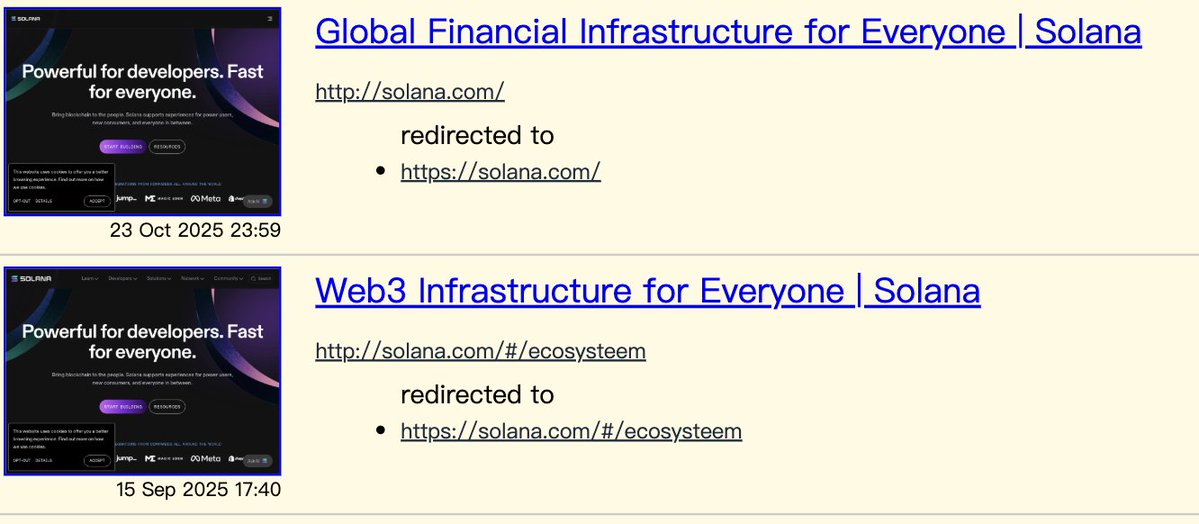
The implications behind this are profound—Solana is actively transforming "blockchain technology" into infrastructure, emphasizing its financial attributes and institutional application capacity. Solana's financialization strategy is gaining substantial support and investment from major financial institutions (such as Visa, Stripe, PayPal, Apollo, BlackRock, etc.), with institutional participation entering a phase of product implementation and scaling, rather than normal technological exploration or conceptual focus.
Solana is expected to be increasingly adopted by both traditional and emerging financial sectors as the default platform for asset issuance, stablecoins, RWA management, and financial innovation. Unlike the previous simple investment in Solana's token price, the more critical new era is "doing finance with Solana," allowing on-chain infrastructure to truly become the network for global capital and financial markets. This role upgrade will lead Solana institutions from being foundational tools of Web3 to a global internet capital network, achieving deep integration of institutional financial value and compliant applications.
Strategic Positioning Transformation: From Infrastructure to Financial-Specific Platform
In 2025, as the meme market cools down, the market begins to reflect on Solana's long-term prospects: besides the meme coin effect, what else does Solana have left?
In fact, with the market's attention, Solana has completed a comprehensive leap from technical prototype and basic ecological construction to application sectors over the past two years.
Most people previously focused on the traffic sector and "hit innovations" on-chain, but a deeper analysis of the Solana ecosystem reveals the latent power of financial infrastructure—DeFi, assets, stablecoins, RWA, AI, NFTs, and other specialized fields are becoming mainstream growth drivers.
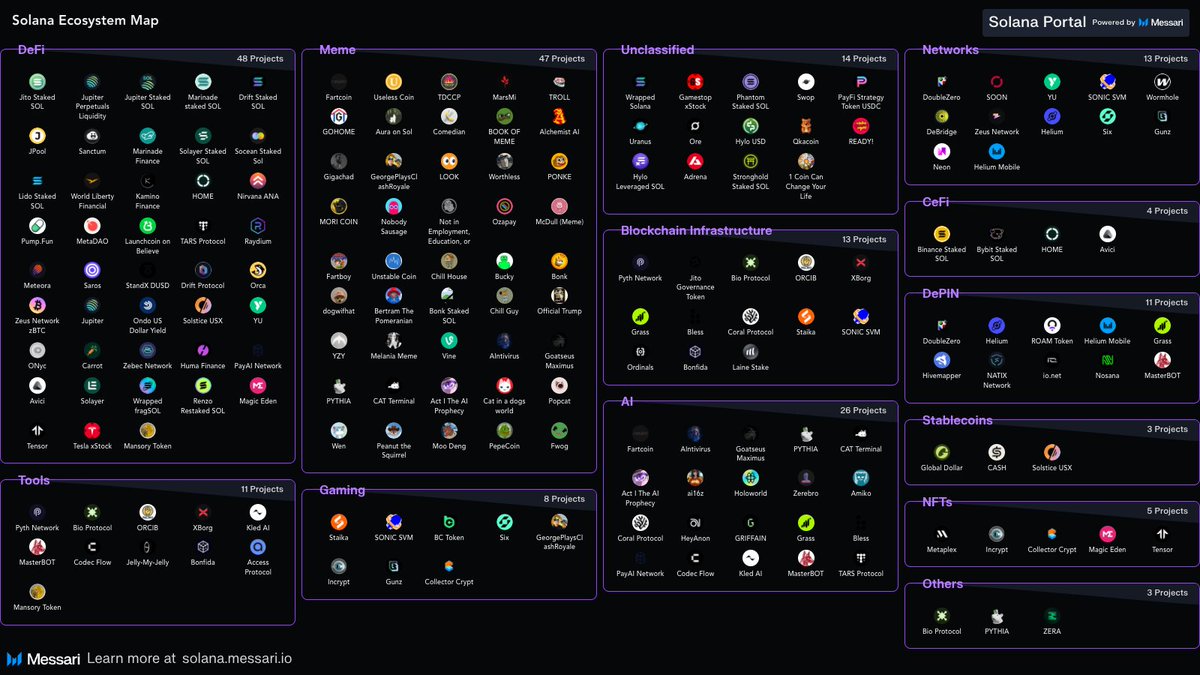
Source: https://solana.messari.io/landscape
With the gradual improvement of various infrastructure and ecological elements, Solana has finally found the main line of development focusing on financial infrastructure.
From a technical data perspective, this is not a fantasy:
Time dimension: Traditional systems operate 9-5 on weekdays, while Solana operates 24/7 without interruption.
Speed dimension: Traditional transfers take 1-5 days, while Solana confirms in 2-3 seconds.
Cost dimension: Traditional international transfers cost $15-50, while Solana costs $0.0005.
Processing capacity: Actual TPS reaches 869 (average per hour), with a peak of 5,289 TPS.
Stablecoins, today's on-chain treasury (DAT), RWA assets, institutional custody, and integrated payments have become the most critical growth engines of the ecosystem, attracting continuous investment from global financial institutions and capital. This not only completes the construction of "blockchain tools" but also enters a new stage of global financial infrastructure.
Solana's Financial Layout Breakthrough in 2025
Solana's Move Towards Finance
On October 23, 2025, at the 11th Wanxiang Global Blockchain Summit, Solana Foundation Chair Lily Liu ( @calilyliu) delivered a keynote speech titled "Building New Finance," publicly elaborating on Solana's financial positioning.
"Solana in finance is like Netflix in entertainment, Amazon in shopping— a disruptor on an internet scale, growing at an unprecedented speed, redefining the path of modern finance."
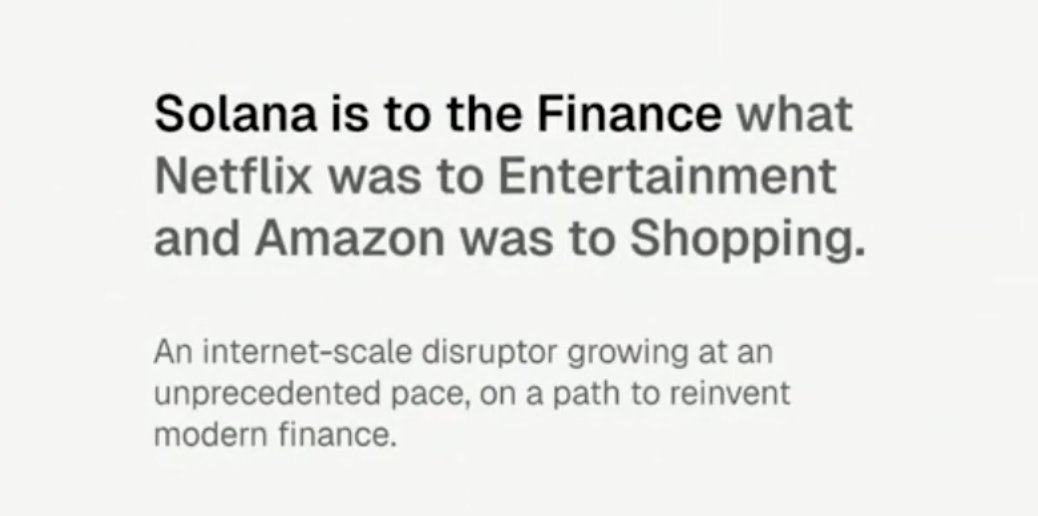
The core of this analogy is: the new platform not only innovates product forms but also expands the ways users access services.
Netflix has made entertainment no longer limited to TV/cinema, but rather available as on-demand streaming anytime, anywhere.
Amazon has transformed shopping from offline to a one-click online e-commerce experience, achieving instant, borderless consumption.
Solana will enhance, automate, and simplify on-chain finance by obtaining limited improvements and processes from traditional banking/exchanges.
Solana's Financial Breakthrough
1. Digital Asset Treasury (DAT): The Solanaization of Institutional Capital
Market Scale Breakthrough
According to CoinGecko tracking data, 19 listed companies cumulatively hold 15.4 million SOL (approximately $3 billion), accounting for 2.5% of the circulating supply.
Committed investment capital exceeds $4.3 billion, including PIPE financing, ATM plans, and convertible bonds.
The annual growth rate reaches over 100%, with the holding amount expected to double by 2026.
Performance of Leading Companies
The following is the performance of specific DAT companies.
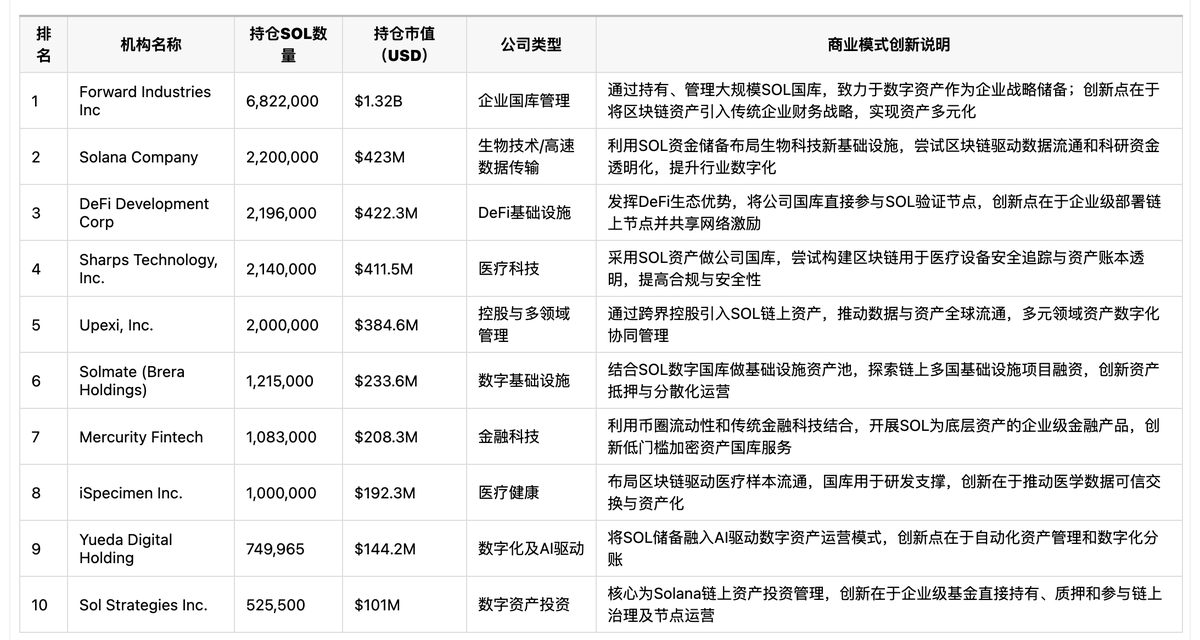
Source: rwa.xyz
DAT Analysis
1. BTC and ETH, SOL has higher on-chain real yields:
Multicoin Capital points out that SOL has yields that BTC and ETH lack. Compared to Bitcoin, Solana's SOL stakers earn a higher average annual yield. The annual yield for SOL staking is about 8%. Of this, approximately 6.19% comes from inflation issuance, while the remaining 1.86% is derived from on-chain real economic activities and MEV. This cash flow driven by real trading behavior and MEV makes SOL more attractive as a long-term capital and digital asset treasury (DAT) underlying asset.
2. DAT companies can achieve higher capital utilization:
DeFi directly matches lending through blockchain and smart contracts without the need for traditional banks and other intermediaries, thus typically significantly reducing operational and matching costs.
By comparing the financing costs provided by traditional banks to listed companies with the financing costs of DeFi, arbitrage operations can be conducted. DeFi offers a network-native financing model that is lower in cost, more transparent, and does not require intermediaries, while the traditional banking system is characterized by centralization, high costs, and strict approvals. This type of DeFi arbitrage not only has high profit margins but can also interact with various counterparties in different ways, forming diverse revenue models.
2. Stablecoin Ecosystem: The Core of Payment Infrastructure
Explosive Growth in Supply
The total supply of Solana stablecoins surged from $5.2 billion at the end of 2024 to $16 billion.
Year-on-year growth of 170%, making it the third-largest stablecoin chain after Ethereum and Tron.
USDC dominates (at $10.6 billion), while USDT is rapidly growing (at $4.5 billion). The surge in Solana stablecoins at the beginning of 2025 coincided with the launch of Donald Trump's meme coin $TRUMP, triggering a wave of capital inflow into the network. The Trump meme coin crossed over into discussions across political, financial, and entertainment circles, quickly breaking the boundaries of the traditional crypto community and bringing significant liquidity and new community energy to Solana and the overall industry. Meanwhile, new regulations such as the U.S. GENIUS Act have brought compliance dividends to the stablecoin industry, leading to a sharp increase in the number of compliant stablecoins issued and used on the Solana chain.
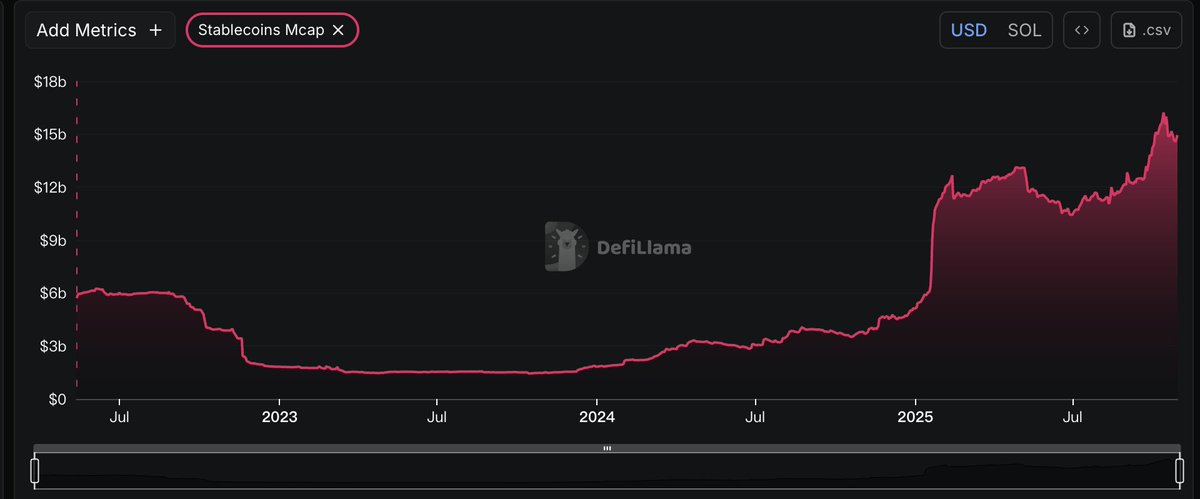
Source: https://defillama.com/
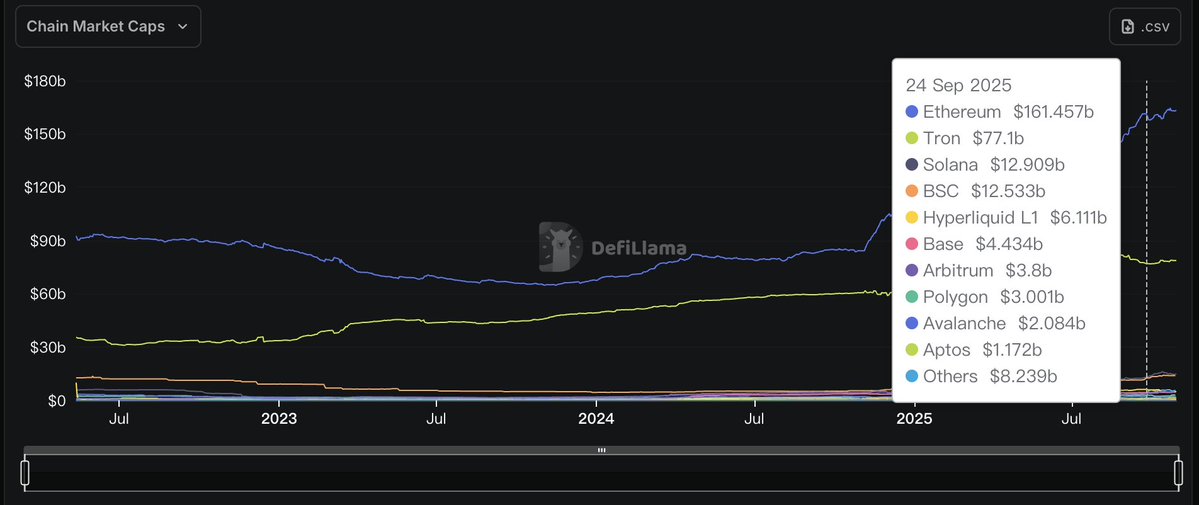
Source: https://defillama.com/
3. Payment Infrastructure: From Pilot to Production-Level Deployment
Payment Infrastructure: From Pilot to Production-Level Deployment
In 2025, Visa officially announced the inclusion of Solana in its stablecoin settlement platform, marking Solana's formal transition from early experimental stages to traditional financial production environments. This milestone places Solana alongside Ethereum, Stellar, and Avalanche, supporting real-time card settlement services for mainstream stablecoins like USDC and EURC.
Visa's construction of a multi-chain, multi-currency settlement architecture for stablecoins enhances the liquidity and payment efficiency of funds on the Solana chain, providing banks, fintech companies, and merchants with faster and lower-cost payment experiences.
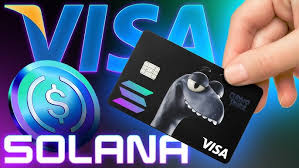
Rapid Breakthrough in Payment Scale
The monthly average stablecoin transaction volume on the Solana chain has reached $50 billion, with daily active users ranging from 3 million to 4 million, demonstrating a strong user base and capital momentum.
As merchant acceptance increases, over 6,000 merchants are accepting crypto payments through Solana Pay, with transaction fees reduced to about 1%, greatly promoting the popularity and practical application of crypto payments.
Real-World Business Application Cases
Mastercard partnered with MoonPay to successfully connect 3.5 billion Mastercard cards to Solana wallets, enabling consumers to seamlessly use their credit cards to interact with the Solana ecosystem, facilitating the everyday use of digital assets.
E-commerce platform Helio collaborated with Shopify to launch an instant crypto checkout solution, effectively avoiding chargeback risks associated with traditional payments, providing a safer and more convenient payment experience for online retailers and consumers.
Western Union announced the launch of the USDPT stablecoin on the Solana chain, with plans to introduce the USDPT payment token in the first half of 2026, which will provide over 100 million Western Union customers with more convenient international remittance services while significantly reducing costs and speeding up transaction times.
Here is a simple comparison:

In summary, the integration of stablecoin settlements has propelled Solana's payment infrastructure from the pilot phase to large-scale commercial deployment, combined with the increasing on-chain transaction volume and rich ecosystem collaborations, establishing Solana's important position as a next-generation global payment network.
4. Integration with Traditional Finance: A Bridge for Trillion-Dollar Assets
R3 Corda Bridge: Deployed Solutions
On September 4, 2025, R3 Labs officially launched a solution to bridge $17 billion in RWA assets from the Corda network to Solana through native interoperability:
Immediately available: Bonds, funds, etc., can be traded on Solana 24/7.
Trustless: Native cross-chain, no third-party custody required.
Scale effect: Connecting institutional clients like DTCC and Nasdaq.
Institutional Custody Solutions
Helius: Manages 13 billion SOL in delegated staking, providing enterprise-level services for The Solana Company and others.
Anchorage Digital: Offers federally chartered SOL custody, integrating Jupiter DEX for DeFi access.
BitGo: Added Solana support, serving institutional ETFs and corporate treasuries.
5. ETF Progress
1. Overview of Global Solana ETF Compliance
In 2025, Solana spot ETFs officially entered the global mainstream capital markets, becoming the first mainstream Layer 1 asset to achieve the dual innovation of "spot + staking" after Bitcoin and Ethereum. ETF applications and implementations are underway in the U.S., Hong Kong, Canada, Singapore, and other regions, promoting institutional and retail user compliance in the financial transformation of the SOL ecosystem.
United States: The SEC accelerated the approval of SOL ETFs, with leading institutions like Bitwise (BSOL) and Grayscale (GSOL) receiving approval for spot and staking ETFs, allowing investors to not only hold SOL assets but also automatically earn staking rewards, with ETF net value including annual returns.
Hong Kong: Huaxia Fund launched Asia's first Solana spot ETF, which only holds native SOL without on-chain staking rebates, fully reflecting a robust compliance orientation that meets local high standards for custody and regulation. The ETF supports multi-currency settlements (HKD, USD, RMB), significantly lowering the entry barrier for Eastern investors into the Solana ecosystem.
Canada/Singapore: Several asset management companies are exploring spot + staking fund products, gradually aligning financing and custody models with those in the U.S. and Canada, driving regional innovation.
2. Spot ETF vs. Staking ETF: The Underlying Logic of Institutional Favorites
Spot ETF: Directly holds SOL and circulates in traditional securities accounts, allowing investors to easily participate in SOL price fluctuations, suitable for retail and institutional clients who prioritize liquidity and entry barriers.
Staking ETF: The fund holds SOL for on-chain staking, earning approximately 7% annual returns, with earnings directly included in the ETF net value, allowing investors to avoid on-chain node operations. The U.S. and Canadian markets have already achieved automated yield distribution, enhancing product attractiveness and capital utilization efficiency.

3. Investment Impact and Industry Significance
The globalization of Solana ETFs not only lowers the technical barriers to blockchain investment but also promotes market compliance and transparency. The emergence of staking ETFs signifies that digital assets can drive real cash flow and enhance capital efficiency, becoming important vehicles for DeFi, corporate treasuries, and RWA management. Solana ETFs have become a bridge and innovation engine for traditional finance to enter the crypto market.
Summary of Solana's Financial Ecosystem Closed Loop
Solana is building a new global financial infrastructure, achieving a closed loop in the financial system through the "entry point" of traditional and innovative assets and the "flow of funds" in on-chain application scenarios:
ETF and DAT—Lowering entry barriers, institutional and public funds flowing into ETFs (exchange-traded funds) and DAT (Digital Asset Treasury) open the door for fiat/capital to enter the Solana ecosystem. ETFs make SOL a compliant mainstream asset, while DAT enables corporate treasuries and listed companies to achieve on-chain asset management and strategic reserves, driving billions of dollars in capital inflow. Together, these two create a sustainable, institutionalized funding supply for Solana, solidifying its foundational position in global finance.
On-chain stocks and RWA—Asset digitization, new forms of capital market applications such as corporate digital treasuries, RWA (real-world assets), and on-chain stocks promote the issuance, custody, and trading of traditional assets, funds, bonds, etc., on the Solana chain, introducing a high transparency and high liquidity digital asset management model to the capital market. The innovative practices of heavyweight enterprises drive the integration of real industries and blockchain finance, enabling global capital to transition from "on-chain management" to "on-chain usage."
Stablecoins and payments—Vibrant funding usage scenarios, with active stablecoins (such as USDC, USDT) becoming the core foundation for payments and circulation on the Solana chain, with supply and transaction volumes growing rapidly, facilitating efficient and low-cost merchant settlements, user transfers, and corporate fund circulation. Through stablecoin payments, the Solana network has become the infrastructure for global payment giants like Visa and Mastercard, processing billions of dollars in transfers daily, with cross-border costs and speeds superior to traditional financial systems.
In summary, Solana has achieved a financial ecosystem closed loop of "capital inflow → on-chain circulation → application scenario expansion," attracting mainstream capital through ETFs and DAT, creating actual circulation through stablecoins and payments, and deeply landing enterprise and on-chain asset scenarios, realizing a comprehensive leap from foundational infrastructure to institutional applications, becoming a pioneer network in the digital transformation of finance.
The Power of Solana from the East
I. Compliance ETF Innovation: Huaxia ETF and Solana Progress in Eastern Countries
1. Hong Kong First to List Solana Spot ETF
On October 27, 2025, the Solana spot ETF issued by Huaxia Fund (Hong Kong) was officially listed on the Hong Kong Stock Exchange, marking the first connection between the Asian capital market and the Solana ecosystem. Unlike the "spot + staking" innovation in the U.S. and Canada, the Hong Kong ETF currently only holds native SOL, without on-chain staking rebates, fully reflecting a robust compliance orientation that meets local high standards for custody and regulation. The ETF supports multi-currency settlements (HKD, USD, RMB), significantly lowering the entry barrier for Eastern investors into the Solana ecosystem.
2. ETF Dynamics in Korea, Singapore, and Other Eastern Countries
Korea and Southeast Asia have not yet officially approved Solana spot ETFs, but institutional interest continues to rise. The capital markets in Singapore and Australia have seen attempts at derivative ETFs and fund products targeting SOL, with some public funds in Singapore trying to align with the U.S. and Canadian spot ETF route, opening local compliance channels. Korea's Upbit has also opened services for Solana asset on-chain and circulation, promoting compliance innovation.
3. Breakthrough in Compliance Towards Staking Innovation
Currently, most Asian ETF products are purely spot-based and do not involve staking rebate functions, which is related to the high standards of control by the Hong Kong Securities and Futures Commission and the Monetary Authority of Singapore regarding node security and third-party custody. In the future, as security solutions mature and regulatory pressures ease, staking ETFs are expected to land in the Asia-Pacific region, making SOL "holding + earning" mainstream and participating in the global on-chain economy.
II. Enterprise-Level Applications: Solana's Collaboration with Local Leading Enterprises
1. CMB International and On-Chain RWA Innovation
In August 2025, CMB International, in collaboration with DigiFT, Singapore OnChain, and Hong Kong's new public fund, was the first to issue a dollar money market fund as an RWA asset, using Solana's multi-chain ecosystem for custody and distribution, promoting the "on-chain subscription" of Hong Kong and Singapore fund products, strengthening the connection between financial institutions and on-chain infrastructure. This move significantly enhances the digital circulation efficiency of "real-world assets" and broadens traditional financial compliance asset custody methods.
2. Huawei Cloud and Solana
Huawei Cloud has been actively laying out Web3 infrastructure, distributed computing, and enterprise multi-chain services, while Solana is a public chain with high performance and an active developer ecosystem, showing strong potential in the Asia-Pacific region and enterprise-level application expansion. Combining the needs of cloud service providers for high-frequency trading, data storage, and node custody on-chain, Huawei Cloud is expected to provide more stable, compliant, and efficient infrastructure support for Solana ecosystem projects. It will offer direct integration capabilities between on-chain data and cloud systems for Asia-Pacific enterprise clients, promoting the integration of fintech and the real economy.
At this year's Token2049 event, we also saw the presence of @Solana_zh alongside Huawei.
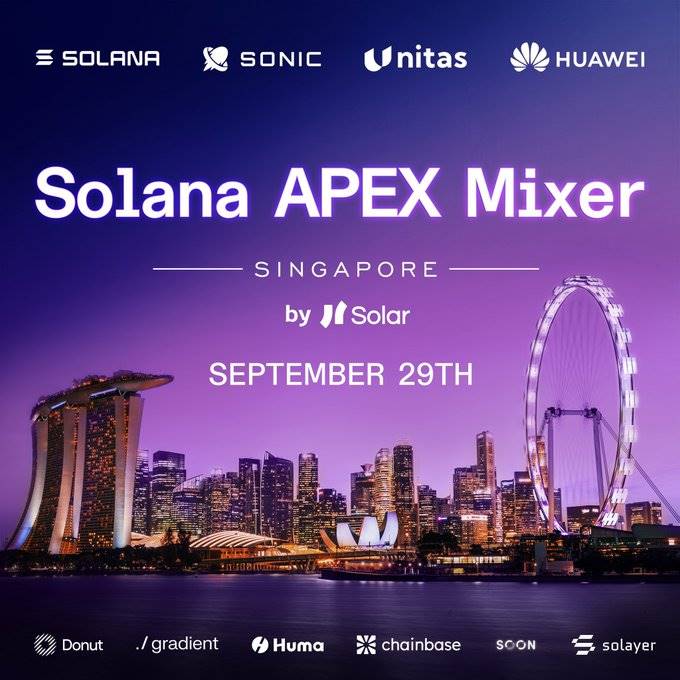
III. The Power of Transformation in the Asia-Pacific: Solana's Ecological Development in Japan and Korea
1. Ecological Activation in Korea and Japan
The open blockchain policy in South Korea has allowed the Solana ecosystem to penetrate rapidly, with exchanges like Upbit offering services for the on-chain circulation of Solana assets. Multiple Korean capital and internet companies are exploring collaborations with Solana's DePIN (Decentralized Physical Infrastructure Network) to achieve various applications such as data notarization, IoT device settlements, and Web3 applications. Japanese capital continues to invest in Solana NFTs and DeFi projects, promoting global innovation and local collaboration.
2. Southeast Asia as a Web3 Hub
Vietnam, Thailand, and Singapore have become the largest user bases and high-density innovation hubs for Solana in the Asia-Pacific region. Each year, the Asia-Pacific Solana Summit attracts thousands of entrepreneurs and development teams, giving rise to new projects such as native stablecoin applications, cross-chain RWA protocols, and on-chain data custody. Solana's high TPS, low latency, and low-cost characteristics align perfectly with the mobile, payment, and cross-border financial needs of Southeast Asia.
3. DePIN and Hardware Industry Synergy
The Asia-Pacific manufacturing and hardware supply chain has become the primary manufacturing base for Solana's DePIN project equipment. Regions like China, Vietnam, and Malaysia provide essential hardware such as mining machines and mobile nodes, supporting the distributed computing needs of Solana. The large population dividend and the widespread adoption of mobile internet accelerate the daily application of the Solana ecosystem in areas like mobile payments, gaming, audiovisual entertainment, and digital identity.
4. Community-Driven Innovation Acceleration
The vast digital native population and highly active young communities in East Asia and Southeast Asia make Solana one of the most vibrant public chains in the Web3 ecosystem, driving global liquidity and innovation to "flow in from the East," creating a collective participation and fusion of capital, projects, and users from both the East and West.
Summary
The Eastern power of Solana not only leads the world in ETF compliance breakthroughs but also extends blockchain from financial investment to the integration of physical industries, data asset custody, and innovative finance through collaborations with local large enterprises like CMB International and Huawei Cloud. The prosperity of the markets in Japan, South Korea, and Southeast Asia, along with the rapid growth of hardware and user communities, collectively shapes a new landscape for Solana in the East, providing a new model for the deep integration of global Web3, capital markets, and the real economy.
Conclusion
As Solana achieves a strategic leap from Web3 technology infrastructure to global financial infrastructure standards in 2025, the entire ecosystem is having a profound impact on fintech, capital markets, and institutional innovation. Solana is not only reshaping the efficiency and model of financial services but also opening new pathways for asset management, payments, investments, and compliance for enterprises and institutions. In the future, Solana is expected to become the core platform and industry standard for the global digital transformation of finance.
Key specific directions to watch include:
The continued growth of the Digital Asset Treasury (DAT) model and its integration with the real economy.
The expansion of stablecoin and on-chain payment scenarios and the establishment of compliance mechanisms.
Large-scale digitization of RWA (real-world assets) and cross-border custody.
Diversified innovation of ETFs and new financial products, along with institutional capital inflow.
Enhanced technical performance and native compliance tools driving traditional financial integration.
Looking ahead to 2026, with the approval of U.S. ETFs, more direct integrations by banks, and the widespread adoption of corporate treasury allocations, Solana is poised to truly become "the Netflix of finance"—making programmatic finance as simple, instant, and ubiquitous as streaming media.
免责声明:本文章仅代表作者个人观点,不代表本平台的立场和观点。本文章仅供信息分享,不构成对任何人的任何投资建议。用户与作者之间的任何争议,与本平台无关。如网页中刊载的文章或图片涉及侵权,请提供相关的权利证明和身份证明发送邮件到support@aicoin.com,本平台相关工作人员将会进行核查。



